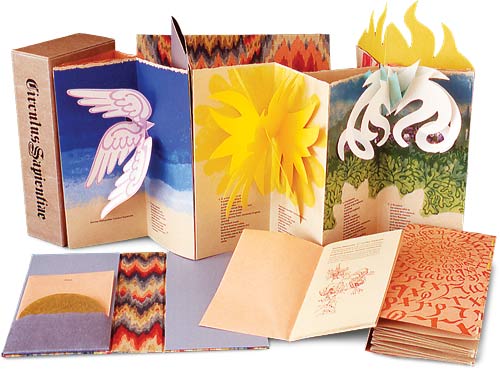FINE PRESSES
Janus Press
"When you work by hand," she said, "you have the luxury
of time that allows the materials to tell you what they want to be. Even
though I produce quite a bit of work, I wait for the work to be in a certain
form. I search for the right action, for the yes." For Van Vliet, what is
all-important in the work is its wholeness. "I don't think of myself as
a meticulous craftsman," she said. Here she spoke of others in her trade
who she would call masterful. In fact, she was consistently generous in
her praise of other fine presses during our talk. "I think of myself as
an orchestrator. I want all the things in a book to fall together. I want
all the parts to need to be there."

Circulus Sapientiea An elaborate construction
inspired by the medieval songs of Saint Hildegard. Published in 2001 in
an edition of 120 copies.
That means that there will always be a sense of
urgency to the work, an urgency derived from necessity that, as Ezra Pound
put it, makes art "news that stays news." And the proof is there: You can
open any book from the Janus Press, regardless of subject, regardless of
year, and feel this freshness and vitality.
Van Vliet has continued growing throughout her
long career. For example, in the late 1980s, she created the first of her "quilt" books,
Aunt Sallie's Lament, based on a poem by Margaret Kaufman. (It was later
produced in a trade edition by Chronicle Books.) There followed an inventive
series of books and broadsides inspired by the mostly anonymous American
quilt makers of the past. In 1989, she produced what Ruth Fine calls "the
most alluring of all the paperwork books," Dido and Aeneas. Fine also calls
it "the most complicated and… arguably the most ambitious of Van Vliet's
publications." This in Janus Press's thirty-fifth year.
These structural innovations-which she generously
reveals in Woven and Interlocking Book Structures, a book she co-wrote with
Elizabeth Steiner-may tend to overshadow the traditional work emanating
from Janus Press. That would be lamentable. In her 1976 rendition of Hayden
Carruth's poem "Loneliness," for instance, the reader feels what Neal Turtell,
the co-curator of the exhibit and the executive director of the National
Gallery Library, describes as Van Vliet's masterful employment of typography "to
be harmonious with the text." One of the things the curators hope this exhibit
will demonstrate is how the seeds for Van Vliet's accomplishments were there
from the beginning. Indeed, if you look carefully at the 1998 Janus Press
publication, Seven Poems by Emily Dickinson, created some twenty years after
the Carruth text, the link is inextricably there; the harmony is now unmistakably
clear and right and even more profound.
Still busy, still working hard, still ranging far
and wide, Van Vliet is presently finishing The Gospel of Mary, a text, according
to Fine, "thought to have been written at approximately the same time as
the better-known Gospels of Matthew, Mark, Luke, and John." Next up is The
Silences Between, poems by the New Zealand writer Keri Hulme, author of
the acclaimed novel The Bone People.
In speaking about the idea of making things deliberately
by hand, as she has done for fifty years, with the plentitude of time for
her artistic vision to reveal itself, Claire Van Vliet said, "That's why,
for example, there's such beauty in a handmade wall." Her fellow Vermonter
and maker of wonderful deliberate works of art himself, Robert Frost, couldn't
have described Van Vliet's vision better himself.


